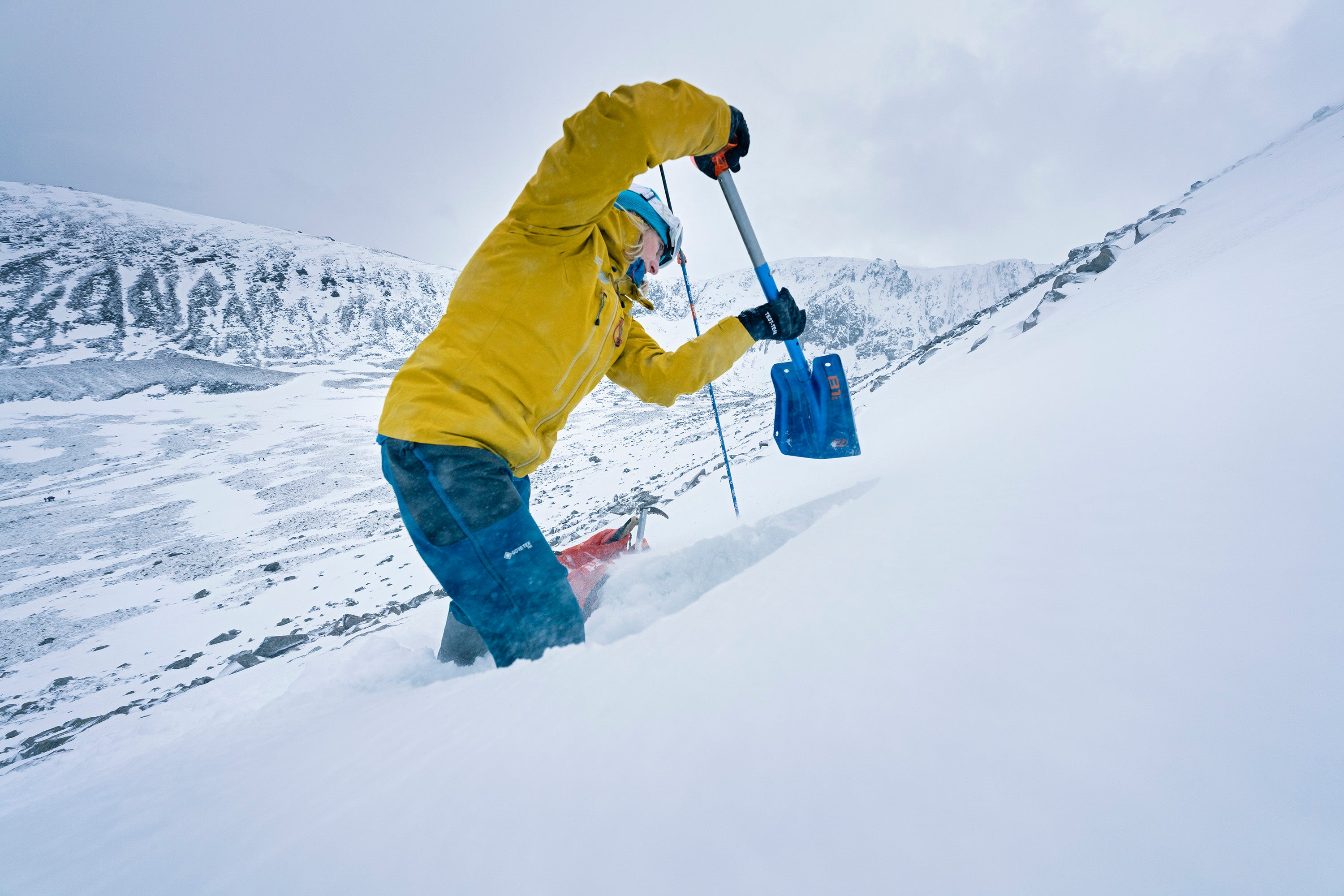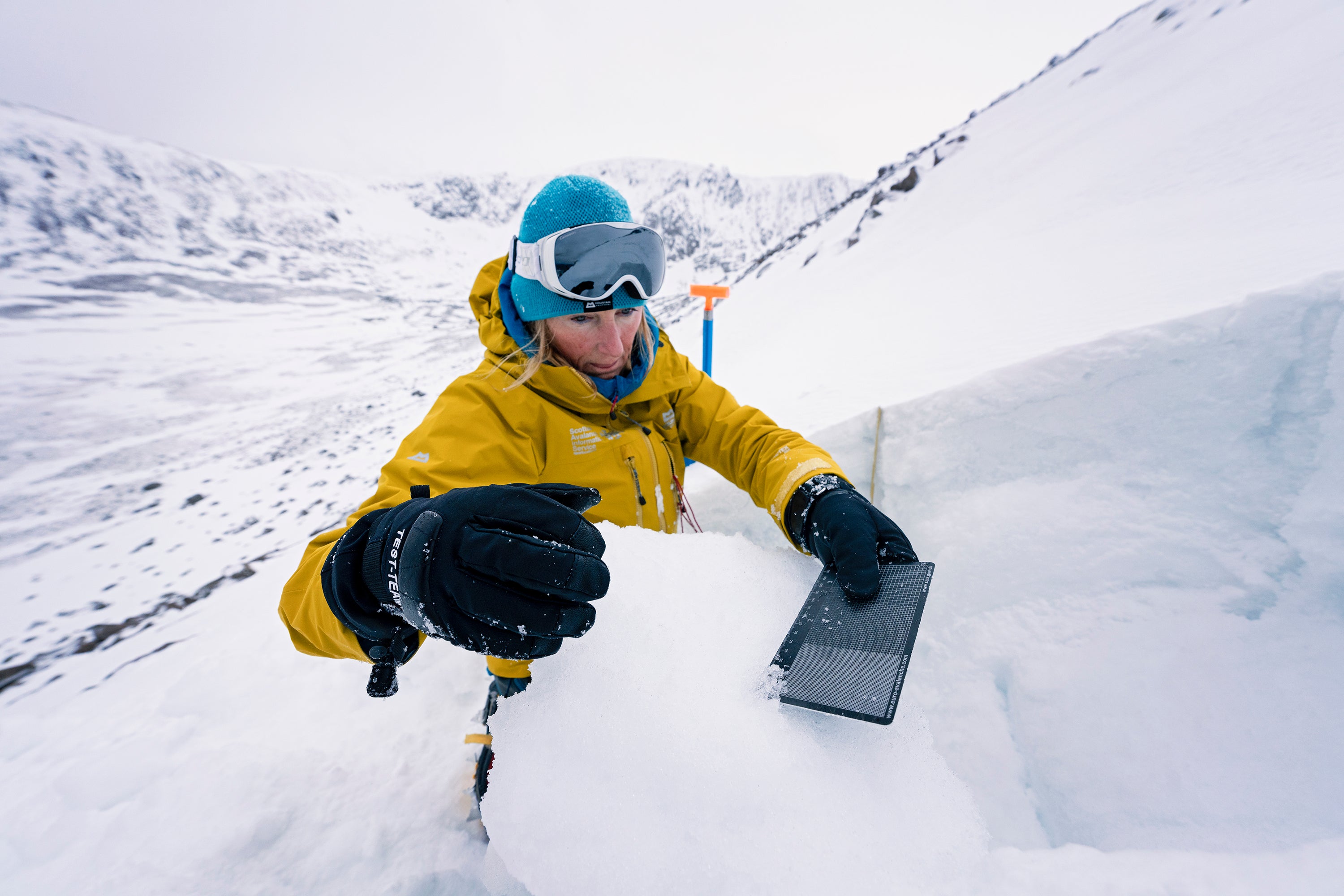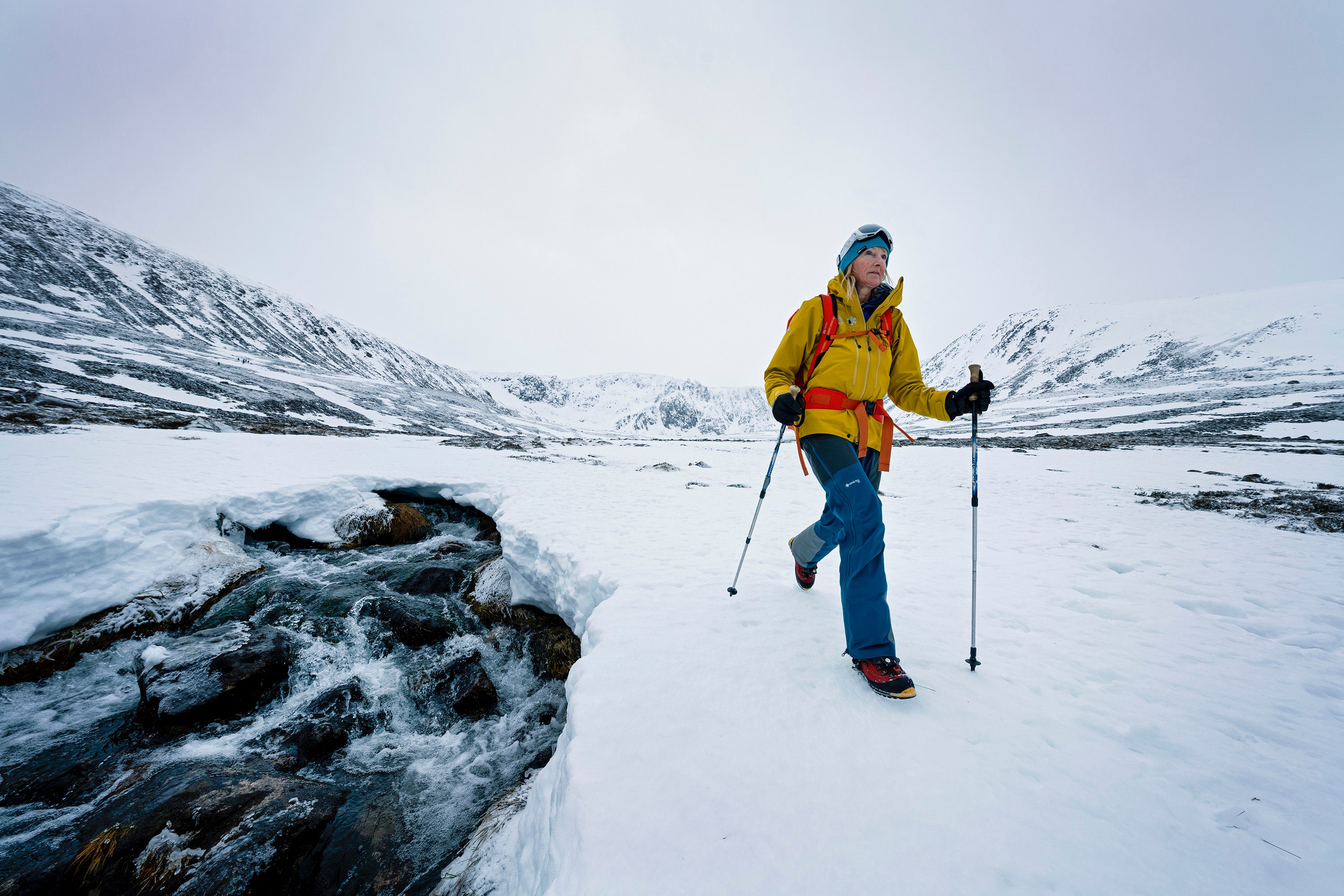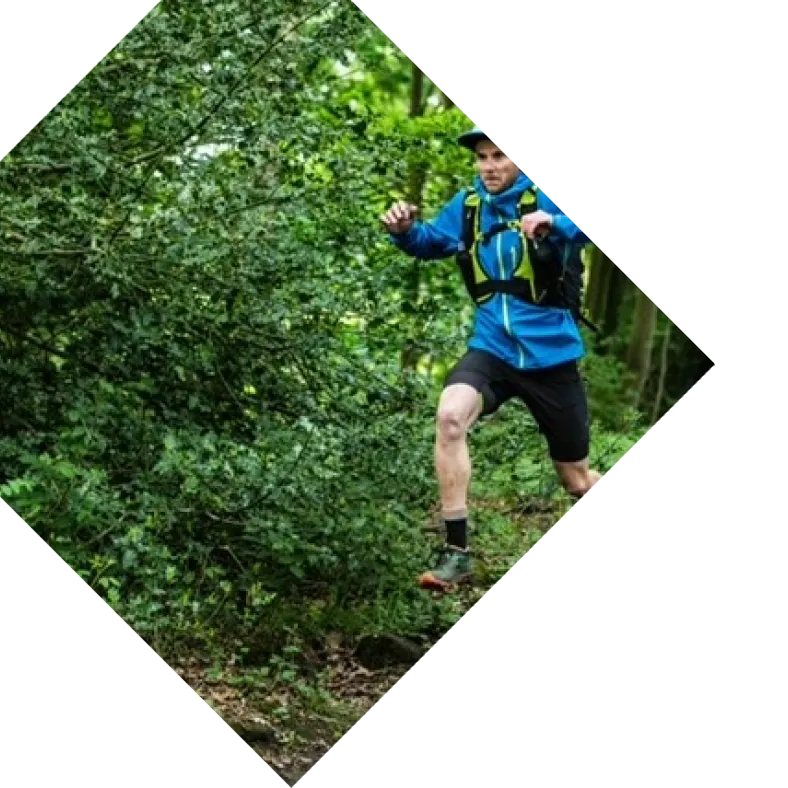Author Tom Hill, learns about the unique three-way partnership between GORE-TEX Products, Mountain Equipment and The Scottish Avalanche Information Service; and how product testing in the most extreme conditions leads to better fabrics and garments for all of us.
I – and I would wager many of you – have a wardrobe dedicated to outdoor kit. Jackets and trousers and gloves. Layers for every eventuality and season. Favourites, back-ups, perhaps even some that are new. And most certainly, the “old faithful”. However, it’s not just garments present in your wardrobe. Hidden at the back, we all have a door to Narnia. Not a real one, obviously, no matter how wonderful that may be. Instead, we have something almost as good; our lifetime of memories on the hill, ready to call upon every time we need a little inspiration to get back outside. I was thinking about this as I waited for my Zoom call to Mark Diggins of the Scottish Avalanche Information Service (SAIS) to connect.
Of those memories, the most vivid are the ones at the extremes. There are the wonderful bluebird summer days, of course, but also those on the other side of the year where we tug up zips as far as they will go, cinch down cuffs and hoods, batten down the hatches and go into battle with the elements. On those days, we are thankful for that wardrobe of gear to reach into. The protection that our clothing offers is the difference between comfort and misery, and at the extremes, life and death. But what if your role involved you setting off into the harshest of winter conditions, over and over again, for weeks on end? For Mark Diggins, Coordinator of the Scottish Avalanche Awareness Service, this is a reality.
The Scottish Avalanche Awareness Service: A vital service

“Field observations are an absolutely fundamental part of our role”, says Mark. “We need to observe and check snow conditions on the ground and do so a few times a week. As a result, our cohort of forecasters can find themselves heading out in some of the most testing conditions imaginable.” The SAIS has been operating since the 1980s. Its aim remains the same as when it was founded, and is succinctly put by Mark as, “providing information to enable people to enjoy the outdoors”. There were 212 avalanches in Scotland in total during the 2020/21 season - it isn’t unusual for climbers, mountaineers, and skiers to get caught out.
The service was borne out of the desire of a handful of guides to share their knowledge, experience, and observations of snow conditions with the wider public. Communication methods have changed significantly in the intervening 35 years though. The SAIS now posts a daily online avalanche forecast, via their website and apps, tailored for six areas. When they first started, they had to rely on signposts at trailheads. It is intricate and complicated work, balancing MET Office information with ground conditions, and a wider knowledge of the topography of the terrain in a given area. It takes four years of training to become a forecaster. Not only does the role need highly competent mountain skills, but each member must learn the snow science; reading the shape of its crystals and their influence on snow stability, as well as recognising how changes in weather and temperature are likely to affect the snowpack.
The perfect test bed for Mountain Equipment and GORE-TEX Products
The very conditions that make the SAIS’s role so important also make it incredibly challenging. Scotland has an almost unique and incredibly varied winter climate. Reflecting on this current winter, much of December and January was met with storm force winds. Since then, colder weather and snow has returned. As a result, you won’t be surprised to hear that the SAIS forecasters have high expectations of the kit they use. “We ask a huge amount from our garments, both in terms of performance, and also durability”, says Mark.
“The team’s comfort and safety are dependent on staying warm and dry in thoroughly challenging weather.” - Mark Diggins, SAIS
It is precisely the demands that SAIS place on their clothing that make their work the perfect test bed for GORE-TEX products and Mountain Equipment; two brands built on making products for use in the harshest of conditions. I spoke to Matt Davis, an R+D Engineer at Gore and Matt Fuller, Product Designer for Mountain Equipment, to find out more.
Matt Fuller: “The SAIS are the perfect partners to work with. Firstly, they condense what might be many years of wear into a single season, but the analytical nature of the forecasters means that the feedback we receive is really detailed. They are able to explain exactly what works for them, and more importantly, what doesn’t…”
The real-world laboratory for GORE-TEX Products

The same applies for the product specialists at Gore. “All of our fabrics go through a long development cycle: starting at the drawing board, before moving on to production samples and thousands of hours of lab tests. GORE-TEX Pro, for example, took five years to develop." - Matt Davis, R+D Engineer at Gore. "The thing is though, our fabrics are designed for the outdoors, not the lab. While we are able to simulate weather – like with our rain tower – nothing is a substitute for real human beings using the product in real conditions.” Matt Davis explained.
“Pro really is performance driven over all other considerations”, Sara Ellis – a GORE-TEX Product Specialist – explains: “During development we tested and tested prototypes to failure; we like to fail at this stage as it allows us to improve.”
When they are not testing prototypes, the SAIS uses Mountain Equipment’s Tupilak Jacket and Tupilak Pant, both constructed with three-layer GORE-TEX Pro 80D. This is the GORE-TEX brand’s most durably waterproof fabric, as well as being 100% windproof and highly breathable. The fabric’s lining layer – “Micro Grid Backer technology” – is designed to slide over other layers easily, allowing freer movement. Perfect, on paper at least, as well as for the typical conditions that Mark and his team find on any given day in the hills.
Sara explains to me that the “Pro” in GORE-TEX Pro isn’t just a snappy title. “The remit for the product really was to be the pinnacle of what we are currently able to achieve. It was designed with a specific eye on professional use; whether that is by guides, professional athletes, those working in rescue services and of course SAIS.” - Sara Ellis, GORE-TEX Product Specialist
Mark Diggins commented: “On a usual day, we’ll be working hard as we climb to a location, generating sweat and heat that the garment needs to deal with. We’ll then often be digging test pits in the snowpack. But after that, we’ll potentially be stopped in one place for an hour or more while we take readings. We need clothing that can deal with both extremes of usage. GORE-TEX Pro and the Tupilak range do just that.”
The purpose might be different, but the SAIS end up presenting very similar needs to Scottish winter climbers, who need a shell layer that will cope with the exertion of the walk in, but also offer the utmost of protection while they are belaying or climbing slowly.
It is a point that Matt Davis reflects on. “There was actually a time when we asked SAIS to test a new prototype fabric for us. Their reaction was that it was actually too breathable for their purposes. They loved it while moving, but they simply cooled down too quickly when they stopped. It’s this kind of feedback that is absolutely fundamental as part of our development cycle. Again, it’s real human beings, doing real things. In this particular example it confirmed what our lab tests told us about the fabric and allowed us to rethink its optimum usage scenario. In this case the fabric was perfect for aerobic activities that are less stop-start.”
People don’t wear fabrics, they wear garments

And of course, fabric isn’t everything. Matt Fuller is keen to remind me that “people don’t wear fabrics, they wear garments”. Cut and features can make or break an end product. Mountain Equipment is a UK-based brand, so their designers perhaps understand the challenges that SAIS (and British winter mountain-lovers) face more than most.
“We spend a lot of time working on the cut of our hoods”, says Matt Fuller, “because we know how important it is to the UK mountain-goer. We have had feedback from SAIS and some of our mountain guide testers saying that our hoods have enabled them to go longer without having to put goggles on in bad conditions.” It’s a simple example of how good design has real-world benefits in the field.
Mark Diggins is inclined to agree. “When you use a piece of clothing virtually every day for an entire season, you get to know every detail. It’s so often the small things that end up mattering, like how accessible pockets are or how easy it is to use toggles with big gloves. When something works in those scenarios, you love it. If it doesn’t, it quickly becomes a frustration.”
Seeking excellence through experience
And that’s something that we can all relate to. Many of us will know the feeling of pulling on a garment in the store and feeling happy enough to make the purchase, only to discover a small niggle somewhere down the line which results in the item being relegated to the back of the wardrobe rather than making new memories.
The end result of this testing process - and the work of Mark, the Matts, Sara and many others - is that you or I end up with a garment we know has been proven in the most extreme of conditions. However, there’s more to it than that.
“I think we make a really good team”, says Mark as we round off the call. I can understand why this three-way partnership between SAIS, Mountain Equipment and GORE-TEX has endured for over a decade now. Each person I speak to talks with passion and care, empathy, and a simple desire to constantly improve. At each stage of the development process is a group of people who are striving to achieve excellence. Sara sums things up well by saying, “SAIS are dedicating themselves to a service. We are dedicating ourselves to keeping them comfortable and safe while they do that”.
So, as much as Gore and Mountain Equipment care about the feedback they receive from the SAIS, they also care deeply about the comfort and safety of the forecasters and appreciate the work they do. Equally, Mark and his team appreciate that both Gore and Mountain Equipment value their feedback and want to give them the best possible tools to allow them to do their job, and ultimately, to help us all enjoy the mountains safely.
About the author
Tom Hill is a freelance outdoors writer and a Contributing Editor for Sidetracked Magazine. When not at his desk, you will find him out in his local Pennine hills, or mountains further afield. He has been a magazine product tester for over ten years and his personal gear cupboard is stuffed to the gills with kit for biking, running, climbing and skiing. Follow Tom on Instagram!
You may also enjoy
View all articles in this category
Products & Brands
From Trail to Town: Meet the HOKA Transport Hike GTX

Products & Brands
Heritage Meets a New Horizon: SOREL and the GORE-TEX® Brand Redefine the Future of All-Weather Style



